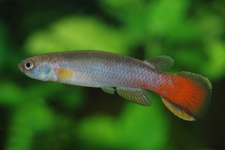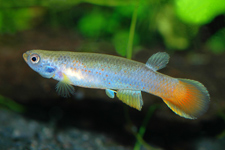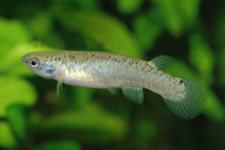History
Alternative name Cynodonichthys tenuis.
Rivulus tenuis was discovered near El Hule, not far from Papaloapan, Oaxaca province, Mexico by Meek himself April 22, 1903 a year before he described the species. Meek only deposited one single male specimen as Holotype at the Chicago Nat. Hist. Mus. Fieldiana Zool. FMNH 4643.
Its name was referring to its slender body (from Latin: tenuis)
The species forms a species complex with: Rivulus brunneus, R. frommi, R. godmani, R. fuscolineatus, R. istmensis, R. monikae, R. rubripunctatus, R. tenuis and R. villwocki.
Known synonyms are: R. myersi and R. hendrichsi.
R. godmani formerly a synonym to R. tenuis was rehabilitated in 2016 by Collier. (See the page of R. godmani.)
Rivulus tenuis is the most derived species of Central America and the northernmost spreading of Rivulus on the main land.
The species is wide spread over several Central American countries like Belize, Guatamala, Honduras and Mexico.
Reproduction
Keeping and breeding is easy but a good cover of the aquarium is necessary because there ability to jump, even true the smallest opening, is unbelievable.
This species can, if there is enough space for them, housed in a tank with more males than one only and several females. If separated before and brought together again however, they can be very agressive to each other and fight to become dominant to others. The best way to have much offspring is to put a pair or an trio in a small tank from 10 liters with a small filter in it or with some airation. On the bottom some peat moss or dark gravel and a floating "mop" to give space for laying there eggs. The fish will, if they become a rich varity of life food, spawn during there whole adult life and produce daily between 5 to 15 eggs.
The eggs should be collected by hand and stored for about 14 days in a small container. Eggs are 1.6 mm and amber colored. It is wise, to add to the water you store the eggs in, some acryflavine to provent fungus coming up.
After hatching the young fry can eat fresh artemia nauplii without any problem. It takes 4 to 5 months to raise them to maturity. Often the number of males is far above the number of females. For some species this can become a major problem for the breeder as he has to raise many young fishes and so become able to distribute a few pairs to other hobbyists. Recent personal tests laerned that lower pH levels during the time of hatching gave a higher percentage of females. To achieve this I use some peat moss that I add to the container with the egss just before they are ready to hatch. This peat moss also is a good way to prevent eggs to become attact by fungusses.
There lifespan can be up to 3 years in captivity.
Remarks :
Rivulus tenuis is easy to keep and breed, a nice species for the beginning hobbyist and a nice coloured one also.
Variations
Map
Meristics
Max. size 6.0 cm.
Dorsal 9.0,
Anal 13.0,
D/A 10.1,
LL scale count (average)37.0
Pre- dorsal length to % SL – 77.0 %
Depth to % SL – 20.1 %
Literature
Meek, S.E. 1904. The freshwater Fishes of Mexico North of the Isthmus of Tehuantepec. Field Columbian Mus. Zool. Ser. (Chicago Nat. Hist. Mus. Fieldiana Zool.) Publication, 5: 101, fig. 27.
Collier G.E., 2016. The Rivulus of Guatemala: Rivulus tenuis Meek 1904, Rivulus godmani Regan 1907 and Rivulus degreefi, sp. nov.. American Killifish Ass. 49(2) table2, Fig. 6.


